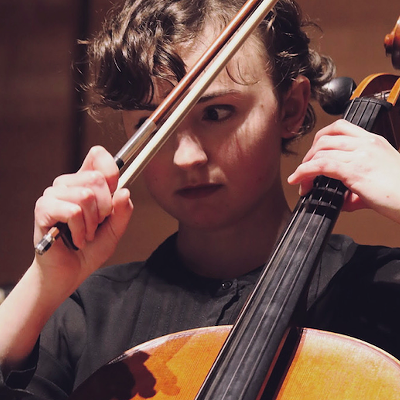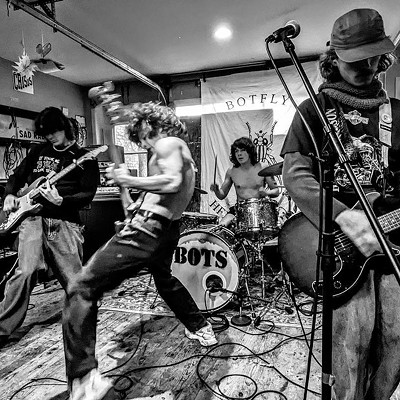f you’ve ever seen Al Tuck play, you know whatI’m talking about. Before every other song, you get a bit of tuning and twanging, maybe half an anecdote, more tuning, at least one false start, a slug of beer and finally, he’s off. As a performer, Al’s never been known to come sharp right out of the gate. He’s a meanderer, a lolly-gagger, a dipsy-doodler of the highest order.
So it’s no surprise that a recent conversation with Tuck went up, down and crabwise over the last 10 years of his life and career. Nor is it unusual that the new album I received for review is neither the same one that’s currently in a few stores around town, nor is it the whole new, new one that will be in stores shortly.
Bear with me, folks. It may not seem like it, but the song will be properly sung.
Six strings, nine lives
Al Tuck wandered over from PEI in the 1980s. Reared on choir singing, baseball and Bob Dylan, Tuck eventually set himself up a conceptually radical band: The Bluegrass Lawnmower. Radical? Well, where else was there to go after punk, synth pop, hair metal and hardcore? Besides grunge?Tuck was thinking, when the shit’s burned to the ground, you go acoustic.
Which there wasn’t a whole lot of going on downtown. But Halifax has always been a scene to dig the shotgun wedding. The Lawnmower’s eponymous 1991 recordings and some of their live gigs featured musicians later to star in Halifax’s so-called grunge heyday and well beyond. Sharing more than just plaid shirts, Al Tuck, with his discombobulated blues, fit right in with the distortorati of the day.
When he formed Al Tuck and No Action in 1993, Friday night at the Deuce might feature Tuck and the band rattling out, like the little train that could, one of Tuck’s classic wry, sparsely arranged story-songs on a stage still smouldering from a messy, mosh-inducing Bubaiskull set. Incongruity followed on the road, when Tuck went a-touring with the likes of jale and the Super Friendz. Rambling, wonky folk-blues guy opens for SubPop poster grrrls? It made a weird kind of Halifax-y sense. Tuck found himself sharing the stage with Nine Inch Nails and Soundgarden. Have I mentioned he is really a solo-acoustic type? You had to be there.
The band’s 1994 recordings, Arhoolie and the recently re-released Brave Last Days (both on Sloan’s murderecords), remain fresh and authentic when a lot of the Halifax stuff from back in the day sounds like… back in the day. But back in the day, when the record labels started handing out contracts, Al was either sleeping it off or getting second helpings in “stuff you gotta go through for a career that lasts longer than 15 minutes.”
At the time, given Tuck’s notorious unreliability, you might have thought the former. But listen to “One Day the Warner” (from Brave Last Days) and its cautionary vision of the signing fever going on: It was released 11 years, hundreds of songs, dozens of cross-Canada tours and three more recordings ago, and it holds true.
Tuck still does everything with minimal assistance from the cogs of industry. Even in today’s alt-folk-friendly climate, he tells me, “I don’t want anything to do with jumping on a wagon. I could have over the years, but why would I want to ride in with an army, when I could ride in on my own sometime.”
Pushing my luck
Somewhere in the middle of the story, things took a turn. There was a hold-up at gunpoint, a gig with Giant Sand, a best friend’s wedding, a trial and a long road home. In 2000, Tuck took himself into retreat in Hubbards and got to work on a new album with a mostly new band (Catriona Sturton on bass, Andrew Glencross on keys and Brock Caldwell on drums). His day job also conveniently retreated, leaving Tuck and the band free to record and tour.
Two thousand one’s The New High Road of Song (Brobdingnagian) brought Tuck a new measure of respect and attention as one of the country’s singular singer-songwriters. Its thicker, more experimental sound was hailed as a departure from Tuck’s traditionalist approach. Featuring a little dub, a little jazz and a lot of groove, the songwriting was still vintage Tuck. It may have been laidback dub-style (“Eliminate Ya”), but you’re still on the back porch.
He says, “At a certain point when I stopped working day jobs or dumb jobs I was living on a theory—a blues theory—to go out on as many limbs as I could just to see where things would land. I never expected to be rewarded—or I must have—I had no clear idea how long it would take.”
The band travelled to the UK and slugged it out around the Golden Horseshoe, as you do. Tuck lived all over the place, hosted open mics, toured sporadically, lost his girl and eventually came to rest on Gottingen Street. For a while, he had furniture and kitchen stuff. He wrote songs.
Then in February 2003, the whole block went up in flames. Tuck got out with his Guild and his skin. So, when the shit’s burned to the ground, what do you do?
You go acoustic.
That’s how she goes
Recalling that fiery day, “February Snow” leads off Tuck’s new recording, 33 1/3. It’s a solo acoustic track, lonesome as can be, sung in a voice hoarse with loss. Passing through the all-adrift ode to lost love “Falling for Catriona” and the sweetly desolate “As Soon As We Kiss,” things start to pick up. By the end of the record, we reach a redemptive, playful New Orleans vibe, still broke-heart, but seeing the light at the end.
“The question on the record is, do you love one or love many?” says Tuck in describing the narrative. “The topic is more your traditional ballad, boy-girl.” He reflects on his own heart’s struggle, chronicled with bare disguise on the new record, and says frankly, “I wanted that topic flushed out. Not fleshed out, but flushed out, like a toilet.”
Assembling the recordings for 33 1/3 began in early 2004, a year to the day after the house burned down. Tuck’s strategy was to just go with the flow, bouncing around different studios (including Blue Rodeo’s Barn in Toronto, Sonic Temple here in Halifax and Lukas Pearse’s north end living room). The diverse sidemen include Matt Murphy (Super Friendz, Flashing Lights), Charles Glasspool and Brian Sanderson (Silver Hearts), Angus Parks on piano, experimental saxophonist Dani Oore and local stalwarts Jeff Arsenault and Brian Bourne. In typical Tuck fashion, there wasn’t a lot of planning, and Tuck refrained from pushing the recordings in any given direction.
“It’s the livest recording I’ve done. It’s almost all live; it’s just what happened. Generally, we jammed it a few times then threw it down. I think it’s all over the map—nostalgic but not necessarily my own brand …If the piano starts blasting away in various styles, that’s contribution, but oftentimes it turned it on. It’s a shared thing.”
Consistency in the recording is due to an honest maturity in Tuck’s lyrics and delivery, a return to the cash-poor comfort of the blues. Many of the tracks, like the snapshot “Let Her Go” riff on “St. James Infirmary,” are fragmented tributes to blues classics. Tuck’s gone way back to his roots, leaving behind experimentation and the epic wit of earlier days.
“It’s a natural process of erosion, to lose extraneous things like that,” he says. As a younger songwriter, “you didn’t know what you were on about necessarily, but as an older person you don’t want to be up there on the stage stuck singing anything irrelevant. It’s way safer to have things that are simple and clear to deliver.”
The hours meets tha man
Al Tuck has always specialized in sly, wry, sad and sweet, and the new release goes down like that, a slug of bourbon, aged and mellowed. That seems to be the state of Tuck overall. He’s got a little management on his side, and plenty of tour dates in good company—including that of his new love, PEI singer-songwriter Catherine MacLellan. You can’t help but smile at the timing.
“After the fire, maybe I was thinking if there’s a guy on the record, he could live through something without any help. That’s kind where it goes, for me,” he says. On 33 1/3, “I kind of burned through whatever it was burning me. I’m getting true love now. I’m not hiding away. I get around a lot more with Catherine.”
Things couldn’t be peachier, it seems. Except that Tuck hates the album cover. And the press photo. And he’s going back in the studio to re-record. And remix a good chunk of the recording. And then rearrange the tracks and repackage it. Other than that, he’s ready for life to start.
See, before, he was just tuning up.














